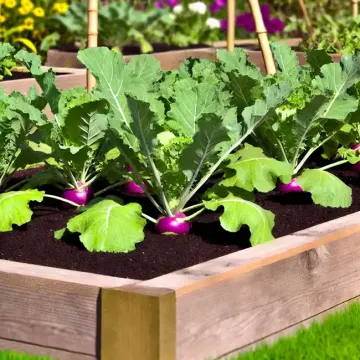Kohlrabi, often referred to as a "German turnip," is an underappreciated yet versatile vegetable in the brassica family. It's grown for its bulbous stem that tastes like a sweeter, milder version of broccoli or cabbage. Kohlrabi thrives in cool weather and is relatively easy to cultivate, making it an excellent addition to any home garden. Whether you're a novice gardener or an experienced grower, kohlrabi can be a rewarding crop.
History of Kohlrabi
Kohlrabi originated in Europe and has been cultivated since the 16th century. Its name is derived from the German words "kohl" (cabbage) and "rübe" (turnip), reflecting its nature as a hybrid between cabbage and turnip-like qualities. Although it gained popularity in Germany and Northern Europe, kohlrabi is now grown and enjoyed worldwide, especially in Asian and Middle Eastern cuisines.
Health Benefits of Kohlrabi
Kohlrabi is a nutritional powerhouse, rich in vitamin C, fiber, and antioxidants. It's also a good source of potassium, vitamin B6, and folate. The fiber in kohlrabi supports digestive health, while the antioxidants help reduce inflammation and lower the risk of chronic diseases. Its low-calorie content makes it a healthy option for those looking to maintain or lose weight.
Culinary Uses of Kohlrabi
Kohlrabi's mild, slightly sweet flavor makes it a versatile ingredient in the kitchen. It can be eaten raw, roasted, steamed, or stir-fried. The bulb can be sliced into salads, grated into slaws, or roasted as a savory side dish. The tender leaves are also edible and can be used similarly to kale or spinach in soups, stews, or sautés. Kohlrabi is often featured in dishes like vegetable stir-fries, gratins, and pickles.
Growing Tips for Kohlrabi
1. Climate and Timing:
Kohlrabi prefers cooler weather, making it ideal for spring and fall planting. It thrives in temperatures between 45°F and 75°F. In most regions, you can start seeds indoors about 4-6 weeks before the last frost date or sow them directly into the garden after the danger of frost has passed. For a fall harvest, plant kohlrabi in mid-to-late summer.
2. Soil Preparation:
Kohlrabi grows best in fertile, well-drained soil with a pH between 6.0 and 7.5. Before planting, amend the soil with compost or well-rotted manure to provide the nutrients kohlrabi needs to grow vigorously. Ensure the soil is loose and well-aerated to accommodate the bulbous stem.
3. Spacing and Planting:
Space kohlrabi plants about 6-8 inches apart in rows that are 12 inches apart. When sowing seeds, plant them about 1/4 inch deep and thin the seedlings to the proper spacing once they reach 2-3 inches in height. Adequate spacing ensures that the bulbs have enough room to develop.
4. Watering and Care:
Kohlrabi requires consistent moisture to grow properly. Water the plants regularly, aiming for about 1 inch of water per week. Mulching around the plants can help retain moisture and prevent weeds from competing for nutrients. Kohlrabi is a relatively low-maintenance crop but benefits from occasional feeding with a balanced fertilizer.
5. Pests and Diseases:
Like other brassicas, kohlrabi can be susceptible to pests such as cabbage worms, aphids, and flea beetles. Using row covers, practicing crop rotation, and encouraging beneficial insects can help keep these pests at bay. Common diseases include clubroot and downy mildew, which can be managed by ensuring proper soil drainage and avoiding overhead watering.
6. Harvesting:
Kohlrabi is typically ready to harvest about 55-70 days after planting. The bulbs should be about 2-3 inches in diameter for the best flavor and texture. Harvest by cutting the stem just above the soil line. Smaller bulbs are tender and sweeter, while larger ones may become woody. Don’t forget to harvest and use the leaves as well.
Fun Facts About Kohlrabi
- Kohlrabi comes in both green and purple varieties, but the flesh inside is always white.
- Despite its unusual appearance, kohlrabi is incredibly versatile in cooking and can be used in place of potatoes or cabbage in many recipes.
- Kohlrabi is a favorite among home gardeners because it matures quickly and can be grown in both spring and fall.
Kohlrabi is an easy-to-grow, nutritious, and versatile vegetable that deserves a place in your home garden. With proper care and attention, you can enjoy a bountiful harvest of this unique crop. Whether you're adding it to salads, roasting it as a side dish, or using it in soups and stews, kohlrabi is sure to become a favorite in your kitchen. Happy gardening!

